Byllis
Q1018544Byllis (Greek: Βύλλις or Βουλλίς): Illyrian city, Greek town.
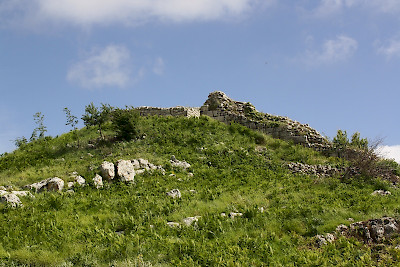
Situated on a hill on the east bank of the river Aoös (modern Vjosa), and controlling the fertile river valley, Byllis was the most important ancient city in southern Illyria. It was the capital of the Bylliones, a local tribe, identified as Illyrian by the Greek author Pseudo-Scylax, who mentions the “Byllionian Illyrians” as living near Amantia in Atintania, the hinterland of the port of Oricum.note This text, which dates to the third quarter of the fourth century, is about as old as an inscription on a sheet of lead found in Dodona, which also mentions the Bylliones.
Origin
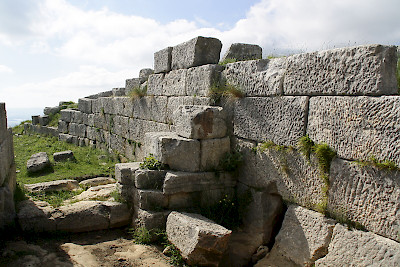
The Bylliones founded their capital in the second quarter of the fourth century BCE, after the demise of the kingdom of the Epirote ruler Bardylis of Molossis, who had exercised control of this region until about 385 BCE. At more or less the same time, the expansion of Macedonia started, where Philip II had become king in 360 BCE. For the Bylliones, building a strongly fortified new city made sense. The oldest tombs in the eastern cemetery east date back to this age and the town was built on a Hippodamian plan, which was also common.
Byllis was not the only Byllionian settlement. Just south of Byllis, in modern Klos, archaeologists have identified the remains of an older Illyrian village that was later renamed Nicaea; further upstream was a fortress at Kalivaç; southeast of Byllis was another fortress at Rabie; to the northeast, there were settlements near modern Gurëzeza and Margëlliç, which are almost certainly identical to the ancient towns of Bargulium and Eugenus. People from all these places must have moved to the new capital, which must have been a real boom town.
Hellenistic Age
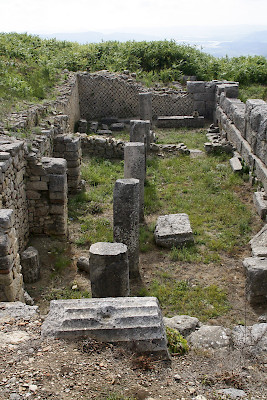
The first stages of Byllis’ history are not very clear, although it seems that Atintania was contested between Macedonia and Epirus. The Macedonian ruler Cassander appears to have conquered southern Illyria in c.314 BCE, reaching even the Adriatic ports of Apollonia (at the mouth of the Aoös) and Dyrrhachium. Two years later, an Illyrian leader named Glaucias liberated Dyrrhachium and may have been in control of the Aoös valley, but we cannot know this for certain. His successor Monunius added Apollonia and resided in Gurëzeza near Byllis. Next, king Pyrrhus of Epirus was in control of Atintania, but the Illyrians recovered their land after 270 BCE. At this moment, the Bylliones started to mint their own coins.
Inscriptions (not written in Illyrian but in Greek) and analogies with the Hellenistic world allow us to understand the political system. The chief executive civil magistrate was the annually elected prytanis, while military powers were shared by the hipparchos and the strategos, the leaders of the cavalry and infantry. There may have been garrison commanders as well, the peripolarchoi. The prytanis could ask advise from the council (“the damiurges”), while laws had to be ratified by the people’s assembly or ecclesia. Several officials served the city itself, like the tamias (tax collector), the city’s secretary or grammateus, and the gymnasiarch (who was responsible for the gymnasium).
By the mid-third century, Byllis had all buildings one would have expected in a Greek city: the gymnasium already mentioned with a stadium, a market square (agora) measuring four hectares and surrounded by sanctuaries and porticoes (stoas), and of course a theater, which could accomodate some 7500 visitors. The impressive walls form a triangle with a circumference of more than two kilometers; the walls were eight to nine meters high and there were six entrance gates, each guarded by a tower. It may have been at this moment that the mythological story, told by Stephen of Byzantium, was invented that Byllis had been founded by Achilles’ son Neoptolemus. (Compare Buthrotum, which presented itself as a new Troy, and Amantia, which claimed to have been founded by Abantes from Euboea.)
The Macedonians still tried to gain control of the city, which usually allied itself to the Roman Republic, although it occasionally switched sides. In 167 BCE, this had serious consequences: the towns of Gurëzeza, Margëlliç, and Klos were completely destroyed, while Byllis suffered as well. It was partly rebuilt and remained partly a ruin, while the other settlements were completely abandoned.
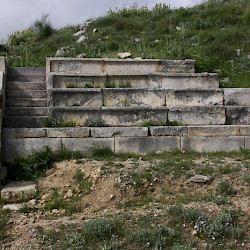 Byllis, Theater seats |
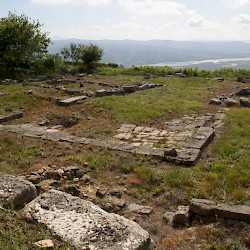 Byllis, Residence B, Southern part |
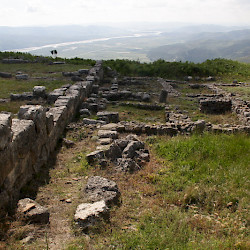 Byllis, Residence B, Northern part |
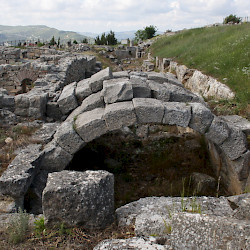 Byllis, Vaulted cistern |
Roman Age
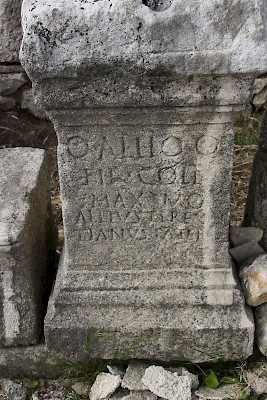
Byllis was now part of the Roman province of Epirus. Being part of the Roman world also meant getting involved in Roman politics, including the deadly civil wars, especially the one between on the one hand Julius Caesar and on the other hand the Senate and Pompey the Great. Caesar mentions that he was allied tp the Bylliones and the Amantians, and could use their cities as a supply bases.note After the assassination of Caesar, Apollonia, Byllis, and Amantia supported Mark Antony and were captured by his opponent Brutus.note Perhaps the walls were rebuilt in the age of the Civil Wars.
In the first century CE, was recognized as a colonia.note From inscriptions, we know that it was called Colonia Julia Augusta. Veterans from Roman legions were settled over here; they may have lived in the luxurious houses with mosaics that have been excavated. The city was gradually expanded: its stoas and theater were rebuilt.
It was a normal Roman city, with normal institutions, a peaceful urban life, city walls falling into decay, and wealthy citizens paying for the public infrastructure. For example, an inscription in the southern rocks mentions how in the year 162, one Marcus Valerius Lollianus, commander of several cavalry units and tribune in the Seventh Legion Gemina, paid for a road from Byllis to Astacia and for a bridge across the river Argias.note
Late Antiquity
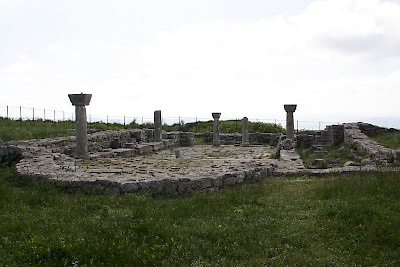
Christianity must have arrived in the fourth century. (If there had been Christians in Byllis before the fourth century, we would probably have read about martyrs during the Diocletianic persecution.) Several churches were built, both inside the city and on the cemeteries outside the walls. Five of them have been excavated, dating from the late fourth (Basilica A) until the mid-sixth century (Basilica C). Basilica B, which took up an area of more than a hectare, is also known as the "cathedral". In 431, a bishop named Felix represented Apollonia and Byllis during the Council of Ephesus. A quarter of a century later, in 458, Byllis had a bishop of its own, Philocarus. These men must have lived in the episcopal palace that has been excavated near Basilica B.
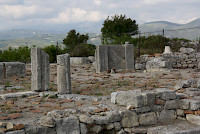
A destruction layer, in which coins were found from the reign of Valentinian II, proves that the city was sacked in the 380s. The attackers probably were Visigoths; their migration through Illyricum is mentioned by the Byzantine author Procopius.note The city – especially its city wall – was rebuilt during the reign of Theodosius II (r.408-450). It is likely that people from Apollonia settled in Byllis, because the river Aoös had changed its course and Apollonia could no longer be the important port it had always been.
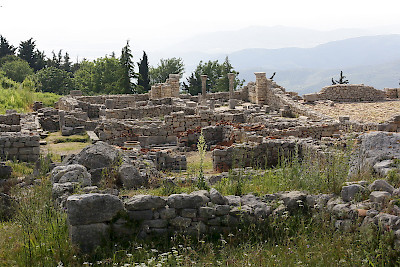
During the reign of the emperor Justinian (r.527-565) the fortifications of Byllis were rebuilt. This can be deduced from several inscriptions, excavated in the monastery of Saint Mary of Ballsh, which mention that a general named Victorinus built a wall to protect Byllis. This wall has been excavated and it is clear that two thirds of the old city had been abandoned. One of these inscriptions poetically mentions that the city no longer complains about the barbarians and is no longer afraid, because it has found in the great Victorinus a man who has rebuilt the city with his own hands. From the same age is a Byzantine bathhouse, which was built next to a Hellenistic vaulted cistern.
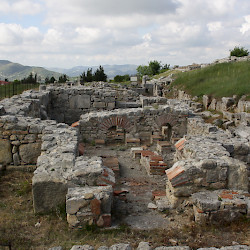 Byzantine Bathhouse |
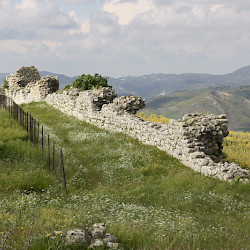 Byllis, Wall of Victorinus |
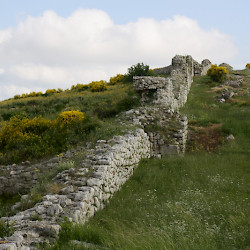 Byllis, Wall of Victorinus |
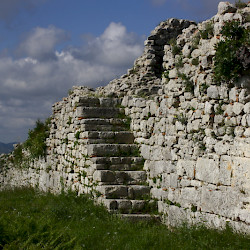 Byllis, Wall of Victorinus |
It was not enough, apparently, to keep the invading Slavs away: in 586, the city was sacked and burned again. Byllis was abandoned and the bishop’s see was moved to a nearby town; its modern name Ballsh is, of course, a corruption of Byllis.
Literature
N. Ceka & S. Muçaj, Byllis. Its History and Monuments (2005)